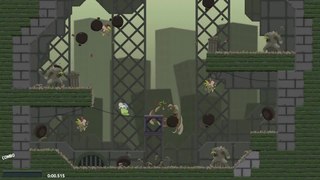Jump 'n' run

As platform game (from English run jump and jump, and racing "or jumping and running ' ) is called computer games in which the player character moves continuously and jumping, and the precise jumping illustrating an essential part of playful action.
definition
The term "Jump 'n' Run" has established itself in German as a computer game term, but is rather unusual in English as a term for the genre. Instead, they generally speak of platform game or platformer for short . Accordingly, such games in the German speaking are sometimes called platform games or short platformer called, with various sub-genres have evolved over time.
For example, games for the slot machine simulator MAME are defined as follows:
- Platform game (generic term)
- Platform / Shooter (with mostly shooting characters)
- Platform / fighter (with mostly characters acting in close combat), see also Side-Scrolling Beat 'em up
- Platform / Jump 'n' Run (largely with demanding skills)
- Platform / Platforms 'n' Ladders (height difference is preferably bridged by ladders)
The transitions are often fluid - for example, even with the highly skill-oriented Jump 'n' Run Crash Bandicoot , kicks and jumps on other characters are necessary in some places in order to move forward.
A distinction is made between 2D Jump-'n'-Runs, in which you can see the character and the surroundings from the side, Jump 'n' Runs with an isometric perspective (diagonal) and three-dimensional mobility of the character, and 3D -Jump-'n'- Runs in which the three-dimensional moveable character moves in an environment shown in central projection.
2D platformer runs are often characterized by horizontal scrolling while the character can be seen from the side. This, for example, climbs up and down ladders or jumps from platform to platform, fights opponents by jumping , collects items for bonus points and often has the opportunity to acquire new skills or weapons .
Usually the direction of travel is from left to right (from right to left, for example in Jungle Hunt ). When playing games with ladders or elevators, there is also vertical scrolling, for example Elevator Action .
technology
The "levels" represent two-dimensional coordinate systems in which most of the game-relevant objects have a position. Often objects that are far from the image section are not calculated (e.g. opponents are stopped) until they become visible, which saves computing power.
The landscape does not consist of a single image file , but is made up of small (e.g. 16 × 16 or 32 × 32 pixels) picture elements, the " tiles ". In this way there does not have to be a pixel-by-pixel image of the entire level in the memory, only the information about which tile is located at a coordinate (individual bytes) and a unique image of each tile. In this way it is possible to keep levels that are huge (compared to the image section) in the working memory and to “scroll” them smoothly. In many games, the tiles also contain metadata , such as B. whether the player stops on it or whether there is something to pick up there. Other metadata and some (particularly moving) objects are often classified in the coordinate system independently of this.
In the simplest case, the foreground and background on tiles are in the same coordinate system (e.g. Commander Keen ). In more modern games, several layers of images are superimposed, for which the front ones define a color as transparent or have an alpha value (e.g. Jazz Jackrabbit 2). The actual game takes place in one shift and the others are used for decoration. Layers in front of the game then scroll faster and those behind slower. In this way, parallaxes are perceived and the impression of a three-dimensional world is created.
Platform milestones
- Space Panic (Universal / ADP Automaten GmbH, 1980) - First platform game (without jumping)
- Donkey Kong ( Nintendo , 1981) - Considered the first jump 'n' run by today's definition, introduced backstory and film sequences
- Pitfall! ( Activision , 1982) - First jump 'n' run without a predetermined sequence of levels
- Ant Attack ( Quicksilva , 1983) - First jump 'n' run with three-dimensional movement
- Lode Runner ( Brøderbund , 1985) - First platformer with included level editor
- Super Mario Bros. ( Nintendo , 1985) - First side-scrolling platformerand one of the most famousplatformergames
- Prince of Persia ( Brøderbund , 1989 ) - animation development using rotoscopy
- Commander Keen Episode 1: Marooned on Mars ( id Software , Softdisk , 1990) - First PC side scroller
- Donkey Kong Country ( Rare , 1994) - First use of pre-rendered graphics
- Jumping Flash! ( Exact Co. & Ultra Co. , 1995) - First three-dimensional polygon platformer in 1st-person perspective
- Crash Bandicoot ( Naughty Dog , 1996) - First polygon jump 'n' run in 3rd person perspective
- Super Mario 64 ( Nintendo , 1996) - First three-dimensional jump 'n' run with a central perspective and largely freely selectable camera position
For other well-known representatives of this genre see: Category Jump 'n' Run .
Web links
Individual evidence
- ↑ a b Jump 'n' Run . In: netzwelt . ( netzwelt.de [accessed on November 2, 2018]).
- ↑ a b Jump and run games definition & explanation | Computer science lexicon . In: Informatik - for pupils and students . ( informatik-verhaben.de [accessed on November 16, 2018]).
- ↑ What does jump 'n' run mean in gaming? Retrieved November 16, 2018 .
- ↑ What is a Platform Game? In: Lifewire . ( lifewire.com [accessed November 2, 2018]).
- ↑ Art of Gaming - Jump'n'Run | ARTE. Retrieved November 16, 2018 .
